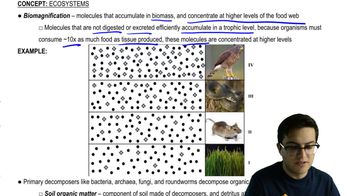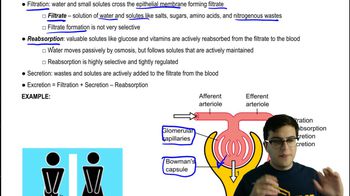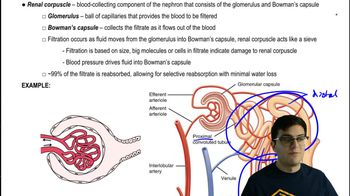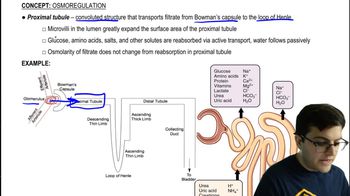Table of contents
- 1. Introduction to Biology2h 40m
- 2. Chemistry3h 40m
- 3. Water1h 26m
- 4. Biomolecules2h 23m
- 5. Cell Components2h 26m
- 6. The Membrane2h 31m
- 7. Energy and Metabolism2h 0m
- 8. Respiration2h 40m
- 9. Photosynthesis2h 49m
- 10. Cell Signaling59m
- 11. Cell Division2h 47m
- 12. Meiosis2h 0m
- 13. Mendelian Genetics4h 41m
- Introduction to Mendel's Experiments7m
- Genotype vs. Phenotype17m
- Punnett Squares13m
- Mendel's Experiments26m
- Mendel's Laws18m
- Monohybrid Crosses16m
- Test Crosses14m
- Dihybrid Crosses20m
- Punnett Square Probability26m
- Incomplete Dominance vs. Codominance20m
- Epistasis7m
- Non-Mendelian Genetics12m
- Pedigrees6m
- Autosomal Inheritance21m
- Sex-Linked Inheritance43m
- X-Inactivation9m
- 14. DNA Synthesis2h 27m
- 15. Gene Expression3h 20m
- 16. Regulation of Expression3h 31m
- Introduction to Regulation of Gene Expression13m
- Prokaryotic Gene Regulation via Operons27m
- The Lac Operon21m
- Glucose's Impact on Lac Operon25m
- The Trp Operon20m
- Review of the Lac Operon & Trp Operon11m
- Introduction to Eukaryotic Gene Regulation9m
- Eukaryotic Chromatin Modifications16m
- Eukaryotic Transcriptional Control22m
- Eukaryotic Post-Transcriptional Regulation28m
- Eukaryotic Post-Translational Regulation13m
- 17. Viruses37m
- 18. Biotechnology2h 58m
- 19. Genomics17m
- 20. Development1h 5m
- 21. Evolution3h 1m
- 22. Evolution of Populations3h 52m
- 23. Speciation1h 37m
- 24. History of Life on Earth2h 6m
- 25. Phylogeny2h 31m
- 26. Prokaryotes4h 59m
- 27. Protists1h 12m
- 28. Plants1h 22m
- 29. Fungi36m
- 30. Overview of Animals34m
- 31. Invertebrates1h 2m
- 32. Vertebrates50m
- 33. Plant Anatomy1h 3m
- 34. Vascular Plant Transport2m
- 35. Soil37m
- 36. Plant Reproduction47m
- 37. Plant Sensation and Response1h 9m
- 38. Animal Form and Function1h 19m
- 39. Digestive System10m
- 40. Circulatory System1h 57m
- 41. Immune System1h 12m
- 42. Osmoregulation and Excretion50m
- 43. Endocrine System4m
- 44. Animal Reproduction2m
- 45. Nervous System55m
- 46. Sensory Systems46m
- 47. Muscle Systems23m
- 48. Ecology3h 11m
- Introduction to Ecology20m
- Biogeography14m
- Earth's Climate Patterns50m
- Introduction to Terrestrial Biomes10m
- Terrestrial Biomes: Near Equator13m
- Terrestrial Biomes: Temperate Regions10m
- Terrestrial Biomes: Northern Regions15m
- Introduction to Aquatic Biomes27m
- Freshwater Aquatic Biomes14m
- Marine Aquatic Biomes13m
- 49. Animal Behavior28m
- 50. Population Ecology3h 41m
- Introduction to Population Ecology28m
- Population Sampling Methods23m
- Life History12m
- Population Demography17m
- Factors Limiting Population Growth14m
- Introduction to Population Growth Models22m
- Linear Population Growth6m
- Exponential Population Growth29m
- Logistic Population Growth32m
- r/K Selection10m
- The Human Population22m
- 51. Community Ecology2h 46m
- Introduction to Community Ecology2m
- Introduction to Community Interactions9m
- Community Interactions: Competition (-/-)38m
- Community Interactions: Exploitation (+/-)23m
- Community Interactions: Mutualism (+/+) & Commensalism (+/0)9m
- Community Structure35m
- Community Dynamics26m
- Geographic Impact on Communities21m
- 52. Ecosystems2h 36m
- 53. Conservation Biology24m
42. Osmoregulation and Excretion
Osmoregulation and Excretion
Problem 16b
Textbook Question
Textbook QuestionFish and other aquatic organisms are exposed to many types of water pollutants, including metals such as aluminum. Although a low level of aluminum is found in unpolluted water, many lakes and streams have an increased level because of mining, sewage treatment, and accidental spills of toxic materials. Aluminum pollution can result in mass fish die-offs. Draw a graph similar to the one here showing how the results would be different if the experiment had been performed on marine bony fish in seawater. (Assume that the osmolarity of seawater is 1100 mOsm and the set point osmolarity of marine bony fishes is 290 mOsm.)
 Verified step by step guidance
Verified step by step guidance1
Identify the key variables for the graph: osmolarity of the environment (seawater) and the internal osmolarity of marine bony fish.
Set the x-axis to represent the osmolarity of the seawater, which is constant at 1100 mOsm, and the y-axis to represent the internal osmolarity of the fish, which is set at 290 mOsm.
Plot a horizontal line on the graph at y = 290 mOsm to represent the constant internal osmolarity of the marine bony fish in response to the external osmolarity.
Indicate on the graph that the internal osmolarity remains constant despite the high external osmolarity, demonstrating osmoregulation in marine bony fish.
Label the graph appropriately, including titles for the x-axis and y-axis, and provide a legend if necessary to explain that the line represents the osmoregulatory ability of marine bony fish in maintaining internal osmolarity.
Recommended similar problem, with video answer:
 Verified Solution
Verified SolutionThis video solution was recommended by our tutors as helpful for the problem above
Video duration:
1mPlay a video:
Was this helpful?
Key Concepts
Here are the essential concepts you must grasp in order to answer the question correctly.
Osmoregulation
Osmoregulation is the process by which organisms maintain the balance of water and solutes in their bodies, crucial for survival in varying environments. Marine bony fish, for instance, have adapted to live in high osmolarity seawater (1100 mOsm) by actively excreting excess salts and retaining water to keep their internal osmolarity around 290 mOsm. Understanding this concept is essential for analyzing how pollutants like aluminum affect their physiological processes.
Recommended video:
Guided course

Osmoregulation and Nitrogenous Waste
Toxicology of Heavy Metals
Heavy metals, such as aluminum, can be toxic to aquatic organisms, leading to physiological and ecological consequences. In fish, exposure to elevated aluminum levels can disrupt gill function, impair osmoregulation, and lead to increased mortality rates. Recognizing the toxic effects of heavy metals is vital for understanding the potential impacts of pollution on fish populations and aquatic ecosystems.
Recommended video:
Guided course

Biomagnification and Decomposers
Graphical Data Representation
Graphical data representation is a method of visually displaying data to illustrate relationships and trends. In the context of the experiment, creating a graph to compare the effects of aluminum on freshwater versus marine bony fish allows for a clearer understanding of how different environments influence the toxicity and physiological responses of these organisms. This skill is essential for effectively communicating scientific findings.
Recommended video:
Guided course

Survivorship

 7:16m
7:16mWatch next
Master Osmoregulation and Nitrogenous Waste with a bite sized video explanation from Jason Amores Sumpter
Start learningRelated Videos
Related Practice


































































